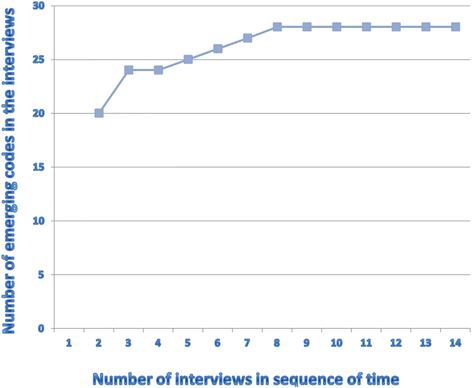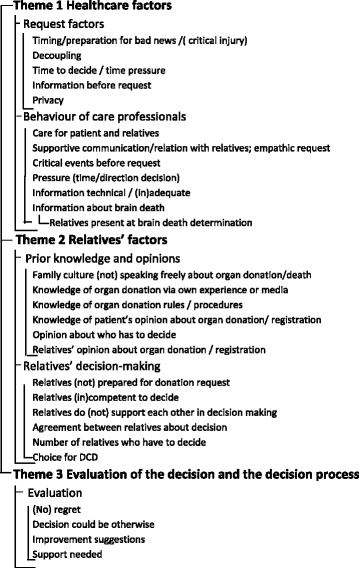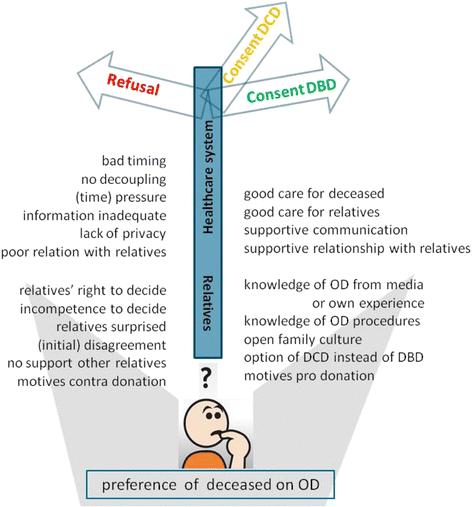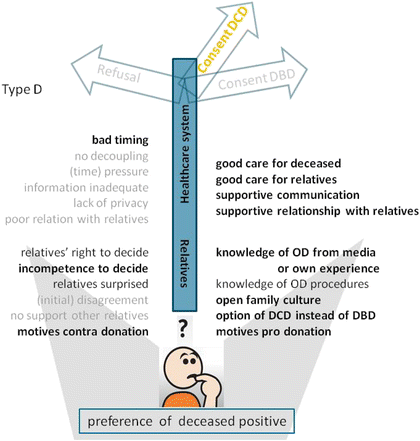Request for organ donation without donor registration: a qualitative study of the perspectives of bereaved relatives
- PMID: 27401351
- PMCID: PMC4940748
- DOI: 10.1186/s12910-016-0120-6
Request for organ donation without donor registration: a qualitative study of the perspectives of bereaved relatives
Abstract
Background: In the Netherlands, consent from relatives is obligatory for post mortal donation. This study explored the perspectives of relatives regarding the request for consent for donation in cases without donor registration.
Methods: A content analysis of narratives of 24 bereaved relatives (14 in-depth interviews and one letter) of unregistered, eligible, brain-dead donors was performed.
Results: Relatives of unregistered, brain-dead patients usually refuse consent for donation, even if they harbour pro-donation attitudes themselves, or knew that the deceased favoured organ donation. Half of those who refused consent for donation mentioned afterwards that it could have been an option. The decision not to consent to donation is attributed to contextual factors, such as feeling overwhelmed by the notification of death immediately followed by the request; not being accustomed to speaking about death; inadequate support from other relatives or healthcare professionals, and lengthy procedures.
Conclusion: Healthcare professionals could provide better support to relatives prior to donation requests, address their informational needs and adapt their message to individual circumstances. It is anticipated that the number of consenting families could be enlarged by examining the experience of decoupling and offering the possibility of consent for donation after circulatory death if families refuse consent for donation after brain-death.
Keywords: Decision making by proxies; Donor registration; Ethics; Informational needs; Organ transplantation; Professional-family relations.
Figures







References
-
- Sque M, Payne S, Clark JM. Gift of life or sacrifice?: Key discourses to understanding organ donor families’ decision-making. Mortality. 2006;2:117–32. doi: 10.1080/13576270600615260. - DOI
-
- DeJong W, Franz HG, Wolfe SM, Nathan H, Payne D, Reitsma W, Beasley C. Requesting organ donation: an interview study of donor and nondonor families. Am J Crit Care. 1998;7(1):13–23. - PubMed
-
- Christmas AB, Mallico EJ, Burris GW, Bogart TA, Norton HJ, Sing RF. A paradigm shift in the approach to families for organ donation: Honoring patients’ wishes versus request for permission in patients with department of motor vehicles donor designations. J Trauma - Injury Infection Critical Care. 2008;65(6):1507–9. doi: 10.1097/TA.0b013e31818a5cf0. - DOI - PubMed
MeSH terms
LinkOut - more resources
Full Text Sources
Other Literature Sources
Medical

